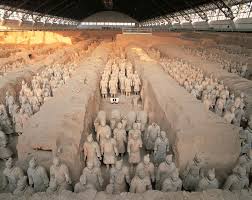
When Was the Mausoleum of Qin Shi Huang Discovered?
The Mausoleum of Qin Shi Huang, a marvel of ancient engineering and one of the largest tombs in the world, wasn't unearthed in a single grand event. Instead, its presence was gradually revealed to the modern world, with the initial discovery occurring in the spring of 1974.
The Unveiling of an Archaeological Wonder
Local farmers in Xi'an, Shaanxi province, stumbled upon fragments of terracotta while digging a well. Little did they know, they had unearthed the first pieces of a vast army of terracotta warriors and horses, forever immortalized in clay to guard their emperor in the afterlife. This accidental discovery marked the beginning of a long and ongoing excavation of the mausoleum complex.
Decades of Exploration, Yet to Be Excavated
Despite over four decades of continuous archaeological work, the central tomb of Emperor Qin Shi Huang remains unopened. This conscious decision stems from a multitude of reasons, each highlighting the complexities and sensitivities surrounding this historical treasure trove.
Why Remains the Tomb Unexcavated?
- The Immense Scale of the Underground Palace:
Historical records, particularly the writings of the historian Sima Qian, paint a picture of an underground palace of staggering proportions. The tomb is believed to be a microcosm of the emperor's empire, complete with palaces, offices, and a ceiling designed to mimic the celestial constellations. Excavating such a vast and complex structure presents unprecedented logistical and technical challenges. * Respect for the Emperor and Ancient Beliefs:
Qin Shi Huang, the first emperor to unify China, holds a revered place in Chinese history. Disturbing his final resting place is considered a sensitive issue, often drawing comparisons to the controversial opening of ancient Egyptian tombs. There's a deep-seated respect for the emperor and a desire to honor the ancient beliefs surrounding death and the afterlife. * The Dragon's Eye:
The strategic location of the mausoleum adds another layer of intrigue. Viewed from above, the mausoleum complex appears to be strategically positioned on a site of significant geomantic importance. Mount Li, where the tomb complex is located, sits at the "eye" of a natural formation resembling a dragon, with Mount Hua and Mount Yao forming the tail and head respectively. This auspicious positioning, known as "feng shui," suggests a carefully chosen site meant to ensure prosperity and harmony even in the afterlife.
FAQs
1. What is the significance of the Terracotta Army?
The Terracotta Army, with its thousands of unique warriors, chariots, and horses, is not just an artistic marvel but also a testament to the military might and ambition of Qin Shi Huang. It provides invaluable insights into the military organization, weaponry, and cultural practices of the Qin dynasty.
2. Are there any plans to excavate the main tomb in the future?
While there's a strong desire within the archaeological community to uncover the secrets of the main tomb, there are no immediate plans for excavation. The focus remains on preserving the site, developing non-invasive exploration techniques, and continuing to study the vast treasures already unearthed.
3. What is the legacy of Qin Shi Huang?
Qin Shi Huang's reign marked a pivotal period in Chinese history. He is credited with unifying China, standardizing its written language, weights and measures, and implementing large-scale infrastructure projects like the Great Wall. Despite his achievements, he is also remembered for his ruthless methods and autocratic rule. His mausoleum, shrouded in mystery and grandeur, serves as an enduring reminder of his complex legacy.